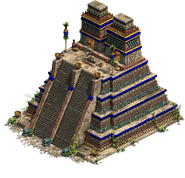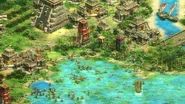| This article is about the civilization in Age of Empires II: The Conquerors. For the civilization in Age of Empires III, see Aztecs (Age of Empires III). |
| “ | Wage Garland Wars against your neighbors, rule a vast empire from a floating city, and defend it from the Spanish conquistadors with droves of experienced infantry. Harness the power of the gods through austere priests with a thirst for human sacrifice! Backed by a thriving economy, unstoppable hordes of Jaguar Warriors and Eagle Warriors will tear your enemies to shreds! | ” |
| —Description[1] | ||
The Aztecs' civilization theme
The Aztecs are a Native American civilization introduced in Age of Empires II: The Conquerors. They focus on infantry and Monks.
Their unique unit is the Jaguar Warrior, the highest rank of warrior in the Aztec army, wielding a wooden club studded with obsidian sharp shards. The Jaguar Warrior is thus a heavy infantry unit which is strong against other infantry units. Their Castle Age unique technology, Atlatl, represents a tool employed by hunters and Warriors that was used for throwing spears or javelins. Their Imperial Age unique technology, Garland Wars, references the "flower wars" which the Aztecs organized among their allies in order to provide more sacrifices. The Aztecs were also known as a hard working and innovative civilization, and their Villagers carry more resources (and got the Loom technology free before The Forgotten). Being a highly military civilization, the Aztecs also have a general creation speed bonus across the board for all their military units. They were famous for their bloody and ardent faith, with their Relics generating extra gold and their Monks receiving extra HP per each Monastery technology researched, allowing their Monks to join other soldiers on the battlefield. The Aztecs did not have horses or gunpowder. Thus, they completely lack Stables (and with it the entire cavalry branch) and cannons. Also, they start random map games with an Eagle Scout (an Eagle Warrior in The Conquerors) as a scouting unit instead of a Scout Cavalry.
Overview
The Aztecs are a Native American civilization. As such, they lack any access to horses and with it, access to cavalry, including Cavalry Archers. They possess some of the strongest infantry, despite lacking Halberdiers. Their archers are below average without Thumb Ring and Ring Archer Armor, but their Skirmishers are still very strong with Atlatl. The Aztecs are strong in the siege weapon department with Siege Rams, Siege Onagers, and Siege Engineers. Their navy is weak, lacking almost everything apart from the fully upgradable Fast Fire Ship. But their Monks are the best in the game with access to all religious technologies and an extra 5 HP for every one researched. Their defenses are below average. The Aztec economy is one of the strongest in the game, due to their villagers carrying +5 resources.
Campaign appearances
The Aztecs have a campaign devoted to their civilization: Montezuma. They also make a brief appearance in the Dos Pilas scenario.
Characteristics
Unique unit
 Jaguar Warrior: Strong infantry with an attack bonus against other infantry
Jaguar Warrior: Strong infantry with an attack bonus against other infantry
Unique technologies
 Atlatl: Gives Skirmishers +1 attack and range.
Atlatl: Gives Skirmishers +1 attack and range. Garland Wars: Gives infantry +4 attack.
Garland Wars: Gives infantry +4 attack.
Civilization bonuses
- Start the game with an Eagle Scout.
- Villagers carry +5 extra resources.
- All military units are created 11.1% faster.
- Monks gain 5 HP for every researched Monastery technology.
- Start with +50 gold.
Team bonus
Changelog
The Conquerors
- Start the game with an Eagle Warrior.
- Jaguar Warriors have 0 pierce armor.
- Elite Jaguar Warriors have +10 attack against infantry.
- Cannot build Demolition Ships.
- With patch 1.0b, Loom is free.
- All military units are created 18% faster.
The Forgotten
- Free Loom removed, start with +50 gold instead.
- Now start with an Eagle Scout instead of an Eagle Warrior.
- Atlatl introduced.
- Jaguar Warriors now have 1 pierce armor.
- Elite Jaguar Warriors now have +11 attack against infantry.
The African Kingdoms
- Initially cannot build Demolition Rafts. In patch 4.8, they were added to the technology tree.
- With patch 4.8, the Demolition Ship was added to the technology tree.
Definitive Edition
- With update 37650, all military units are created 11.1% faster.
In-game dialogue language
Historically, the Aztecs spoke Classical Nahuatl, an Uto-Aztecan language related to Comanche among others. In-game, however, Aztec units seem to speak an unrelated Mayan language, though not the one spoken by the Mayans (K'iche').
For example, female lumberjacks say ajsi, which means "wood worker" in some Mayan languages like Yucatec (si means "wood", aj- is a prefix denoting profession). Fisherwomen say ajkix, formed by the same prefix aj- and kix, the word for "fish" in another Mayan language, Mam. Finally, builders say ajtsaq, which means "bricklayer" in several Mayan languages including Kaqchikel.
The language used could be an unidentified Mayan language, or possibly a mix of Yucatec, Kaqchikel, K'iche', Mam, and others.
General dialogue
Note: Spelling speculative
- Oc - Yes
- Cuh - I'm going (?)
- Comantsi
- Bant' ney
- Bantéwon
- Ic com
- Che?
- Akhsi - Lumberjack (F)
- Aksay - Lumberjack (M)
- Achium - Gatherer/Hunter (F)
- Asku - Gatherer/Hunter (M)
- Akhkishe - Fisherman
- Tsag genani - Farmer/Miner (F)
- Tsag onan - Farmer/Miner (M)
- Achtsag - Builder
- Achuin tscha - Repairer
- Zebiok - Attack
- Zhunqey - Attack
Monks
- Comantsa
- Bintchang
- Necchio
- Ochelokei
AI player names
When playing a random map game against the computer, the player may encounter any of the following Aztec AI characters:
- Acamapichtli ("Handful of Reeds", 1356-1395): First tlatoani of the city-state of Tenochtitlan, ruling from 1376 as a vassal of the Tepanecs. He expanded Tenochtitlan's island, enacted the first Aztec laws, and built the first temple on the site of the Great Pyramid. He favored diplomacy and there were only two or three wars during his reign: first in support of the Tepanecs, and after he won the right to wage war on his own, mostly against Xochimilco for the purpose of collecting chinampas to add to Tenochtitlan's.
- Ahuitzotl ("Water Thorny", r. 1486-1502): Eighth ruler of Tenochtitlan. Greatly expanded Aztec territory by defeating the Huastecs, Mixtecs, Zapotecs, and other Pacific coastal peoples up to Guatemala. Further developed Tenochtitlan and its Great Pyramid.
- Axayacatl ("Face of Water", 1449-1481): Sixth ruled of Tenochtilan, reigned from 1469. Defeated the Tlatelolcans and Matlatzincans before being bested by the Tarascans, which marred his image as this was the first major defeat of the Aztecs. Preceded his brothers Ahuitzotl and Tizoc on the throne despite being the youngest.
- Chimalpopoca ("Smoking Shield", 1397-1427): Third ruler of Tenochtitlan, reigned from 1417. Supposedly died in Tepanec custody for supporting a Tepanec emperor overthrown in a coup d'etat, but it's been suggested he was actually killed in an Aztec coup d'etat by Itzcoatl and history rewritten to blame the Tepanecs.
- Cuauhtemoc ("Falling Eagle", 1497-1525): Eleventh and last independent Aztec ruler, reigned from 1520. Taken prisoner after the Siege of Tenochtitlan, was later tortured and hanged by Cortés after being accussed of plotting a rebellion against the Spanish. Serves as narrator of the Montezuma campaign where he rises from Eagle Warrior to Emperor, and also appears as the AI personality of the Aztecs in Age of Empires III: The WarChiefs.
- Cuitlahuac ("Carer", c. 1476-1520): Tenth ruler of Tenochtitlan, reigned for 80 days in 1520 before he died in a smallpox epidemic. Led the Aztec rebellion against his brother Montezuma II and the Spanish occupation of Tenochtitlan.
- Huitzilihuitl ("Hummingbird Feather", c. 1379-1417): Second ruler of Tenochtitlan, reigned from 1396. Continued the diplomatic approach of his father Acamapichtli and created the Royal Council to advice him due to his young age. Only fought one war around the time of his death, supporting the Tepanecs against Texcoco.
- Itzcoatl ("Obsidian Serpent", 1380-1440): Fourth ruler of Tenochtitlan, reigned from 1428. Illegitimate son of Acamapichtli and uncle of Chimalpopoca, whom he possibly overthrew. Threw off the domination of the Tepanecs and forged the Triple Alliance with Texcoco and Tlacopan, which became the basis of the Aztec Empire. Also burned the historical codices and replaced them with a state-sanctioned history and mythos that venerated Huitzilopochtli, the god of war.
- Maxixca (a.k.a. Maxixcatl or Maxixcatzin, "Lord Maxixca", ?-1520): Lord of Ocotelulco, one of four components of Tlaxcala, and instrumental agent in establishing the Tlaxcala-Spanish alliance. Died of smallpox.
- Montezuma (a.k.a. Moctezuma, "Angry Ruler"): Two Aztec emperors were named Montezuma - the fifth, Montezuma I (1398-1469, r. from 1440); and the ninth, Montezuma II (1466-1520, r. from 1502). Montezuma I trully created the Aztec Empire by conquering the Tepanecs and Tlatelolcans and expanding to the Caribbean coast, while Montezuma II expanded into the south and pushed centralization and aristocratic rule as a way to consolidate the conquests of his predecessors. Montezuma II welcomed the Spanish into Tenochtitlan before he was killed in the lead up to the Noche Triste.
- Tizoc ("He who makes sacrifices/penance", r. 1481-1486): Seventh ruler of Tenochtitlan, brother of Axayacatl and Ahuitzotl. Conquered the Maya-speaking Huastecs before dying of illness or poison.
History
Political control of the populous and agriculturally rich central valley of Mexico fell into confusion after 1100. Gradually assuming ever-greater power were the Aztecs, probably a northern tribe that had migrated to the valley and occupied a minor town on the shore of the great central lake. They were a society that valued the skills of warriors above all others, and this emphasis gave them an advantage against rival tribes in the region. By the end of the 15th century, the Aztecs controlled all of central Mexico as a military empire that collected tribute from rivals.
The Aztec culture drew upon the experience of those that came before it and invented little that was new. They had an advanced agriculture that supported a very large population. They built immense buildings of grand design and flourished in many arts. They were adept metal workers, but had no iron. Lacking any suitable draft animal, they made no motive use of the wheel.
One of the distinctive features of the Aztec culture was its penchant for sacrifice. Aztec myths dictated that human blood be fed to the Sun to give it the strength to rise each day. Human sacrifices were conducted on a grand scale; several thousand in a single day were not uncommon. Victims were often decapitated or flayed, and hearts were cut from living victims. Sacrifices were conducted at the top of tall pyramids to be close to the sun and blood flowed down the steps. Although the Aztec economy was based primarily on corn (or maize), the people believed that crops depended on the regular provision of sacrificial blood.
The incessant demand for sacrificial victims meant that the Aztecs tolerated loose control over satellite cities because frequent revolts offered opportunities for capturing new victims. During times of peace, “garland wars” were arranged strictly as contests of courage and warrior skill, and for the purpose of capturing victims. They fought with wooden clubs to maim and stun, rather than kill. When fighting to kill, the clubs were studded with obsidian blades.
Despite their great agriculture and arts, the Aztecs appear in retrospect to have been a waning society. They passed on no significant technology or ideas of religion or political theory. Their civilization was brought to an abrupt end by the arrival of the Spanish in the early 16th century. Already devastated by European disease passed by early traders, they fell to a small Spanish army armed with steel weapons, firearms, and riding a few horses. The cruelty of the Aztecs contributed to their downfall by making it easy for the Spanish to enlist allies among the non-Aztecs in Mexico.[1]
Trivia
- The Aztec civilization's icon is modeled on an Aztec shield design depicted several times in the Codex Mendoza (1541).
- Jaguar Warriors wear the same shield in The Conquerors, but not in the Definitive Edition. Instead, they use a design similar to the Eagle Warrior's but with the background in the player's color instead of the foreground. These two designs also appear in the Codex Mendoza.
- The Jaguar Warrior's original shield design is worn by the Xolotl Warrior.
- The presence of siege weaponry is anachronistic, but was intentionally left in due to the designers’ limited time and other resources.







